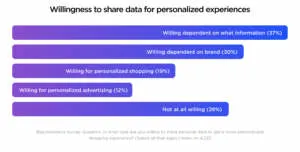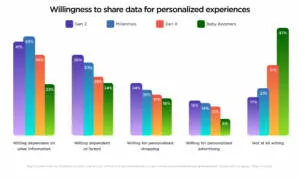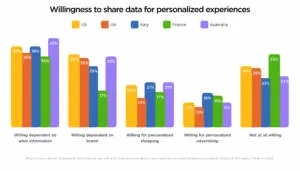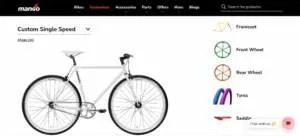
Grow from $1 Million to $100 Million
Explore our collection of resources filled with actionable strategies, expert insights and everything you need to increase ecommerce sales.

Consumer Behavior Trends: Personalizing the Customer Experience


Consumer Behavior Trends: Personalizing the Customer Experience
Get The Print Version
Tired of scrolling? Download a PDF version for easier offline reading and sharing with coworkers.
A link to download the PDF will arrive in your inbox shortly.
These days, it’s no longer abnormal to see ads from your favorite brands pop up in the margins of your laptop screen, or to find a “Recommended for You” section on an online store.
With more and more customers shopping online, ecommerce brands must learn how to blur the line between digital and in-store experiences — and it all starts with personalization.
Whether it’s addressing customers by name via email, displaying products based on a customer’s location or recommending related products during checkout, personalizing the customer experience is key to improving conversion rates and driving home sales.
Global Consumer Report Findings
Needless to say, ecommerce is experiencing massive growth — and change.
Spurred by the global pandemic and numerous advancements in technology, ecommerce has transformed the way consumers interact with brands. With numerous factors influencing the ways consumers buy online, brands will need to keep pace with current consumer behavior trends in order to remain relevant in a competitive landscape.
In our Global Consumer Report, BigCommerce surveyed more than 4,000 online shoppers in the US, UK, Italy, France and Australia to help uncover the major trends that are shaping retail today and in the future. And unsurprisingly, personalization was a significant trend.
As research shows, 73% of consumers expect companies to understand their individual needs and expectations. On top of that, most consumers understand that brands use personal data to create personalized products and messaging.
But for our Global Consumer Report, BigCommerce wanted to understand how personalization impacts the decision to buy, as well as what information consumers are willing to share in order to get a personalized shopping experience.
According to our findings, 72% of consumers are willing to share some type of personal information in exchange for a personalized shopping experience. This reveals a huge opportunity for online retailers to take advantage of customer data in order to create the best online experience possible.

Without a doubt, personalization drives customer loyalty. In fact, a study by Google and Storyline Strategies discovered that 72% of consumers are more likely to be loyal to a brand if they offer a personalized experience with additional rewards and benefits.
But in addition to the onsite experience, consumers also desire personalized advertisements. Another study from Google and Ipsos found that 67% of Google feed users have bought or planned to buy something after seeing a personalized ad on their feed.
Data Privacy vs. Personalization
Of course, when it comes to data privacy, some consumers may be more or less apt to give out their personal information, depending on age, technology expertise and their level of desire for personalized experiences.
According to the EY Global Consumer Privacy Survey, when asked what is most important when choosing to share personal information with a brand, the majority of consumers “point to secure collection and storage (63%), control over what data is being shared (57%) and trust in the company collecting their data (51%)” — which means that as data privacy awareness increases, security and trust are essential.
Even so, comfort levels still vary based on generation.
In our Global Consumer Report, of the respondents who were willing to share their personal information, Gen Z and Millennials were by far the most willing. Growing up as digital natives, younger generations may be more inclined to share personal data due to exposure to the internet and social media.
On the other hand, Gen X and Baby Boomers are less willing to share their data in exchange for a personalized experience. This could be due to a lack of familiarity with new technology or a greater reluctance about the security and protection of their personal data.

What information are consumers most willing to share?
Although many consumers are willing to share their personal data online, there are some types of information they feel more comfortable sharing than others.
Of those willing to share information for a personalized experience, the majority of survey respondents selected email as the type of information they are most willing to share — followed by gender and name in second and third, respectively. This is unsurprising, considering how common it is to see email pop-ups on a brand’s website in exchange for discounts, promotions and newsletters.
But as for social media information, home addresses and phone numbers, customers are less inclined to give out this sort of data. Thus, ecommerce brands need to gauge and remain sensitive to consumer comfort levels when choosing which customer data they use.

8 Personalization Tactics to Improve the Shopper Journey
Most marketers (and customers) are already familiar with basic personalization techniques, such as using the customer’s name in an email. But if you want to stand out from the crowd, your shopper journey needs to be personalized from the moment the customer visits your landing page to when they finally click “Purchase.”
Here are eight key ways you can personalize your customer experience and begin driving conversions.
Chatbots: In lieu of in-store employees, online retailers can utilize chatbots and virtual assistants to help answer questions and provide support 24/7.
Product recommendations: Up-sell and cross-sell by recommending similar or complementary products based on a customer’s previous purchases.
Continuous shopping for returning customers: Just as Netflix allows customers to “continue watching” the last episode they played, online merchants can help streamline the shopping journey by allowing returning customers to pick up where they left off.
Localized and targeted content: Personalize all content based on the customer’s language, region, preferences and other demographics.
Retarget on social media: If a prospective customer leaves your site or forgets something in their cart, regain their attention through a targeted ad on Instagram, Facebook or TikTok.
Navigation adjustment: If a customer frequently visits your site, help make the purchase process easier for them by adjusting the navigation based on previous purchases and site visits.
Personalized emails and SMS marketing: Engage and convert customers through abandoned cart messages, order follow-up emails, “We miss you” and “Thank you” messaging.
User-generated content: One of the greatest drivers of brand loyalty is seeing trustworthy input from fellow customers. Utilize user-generated content by reposting photos, videos and product reviews from customers to help bring your products to life.
Merchant Spotlight: Mango Bikes
BigCommerce merchant Mango Bikes, a UK-based custom bike brand, is a perfect example of personalization in action.

The brand’s website offers a Bike Customizer, where customers can build their ideal bike, personalizing everything from the bike’s model and color to its wheels and handlebars. And if you’re not yet sure what kind of bike you want, Mango Bikes even has its own Bike Finder Quiz, which helps customers find the perfect bike for their skill level, style and terrain — and at the end of the quiz, you can input your email and phone number if you want to be added to Mango Bike’s newsletter and Mango SMS Club.
Each of these personalization tactics is a new opportunity not only for Mango Bikes to increase conversions and drive sales, but also for the customer to receive the ultimate shopping experience.
The Final Word
As the shopping journey moves from physical to digital, there is an increasing need for ecommerce brands to create an online shopping experience that mirrors that of shopping in-store.
Luckily, BigCommerce’s app marketplace features tons of personalization and recommendation tools to help merchants build optimal customer experiences with ease.
But before diving headfirst into personalization, brands first need to understand the importance of data privacy. According to our Global Consumer Report, not all customers are equally willing to share their personal information in exchange for a personalized experience, and comfort levels vary depending on what kind of information is being shared. As a result, online retailers need to be aware of not only who, but how they’re targeting with personalization.
For even more insights into personalization and other consumer shopping trends, check out BigCommerce’s Global Consumer Report.

Haylee is a Content Marketing Writer at BigCommerce, where she partners with the SEO team to craft narratives and blog content. She earned a B.A. in English Literature from the University of Texas at Austin and afterward spent a year abroad to pursue a Master's in International Management from Trinity College Dublin. When she’s not writing, you can usually find Haylee with her nose in a book, enjoying live music or scoping out the best local coffee shops.


